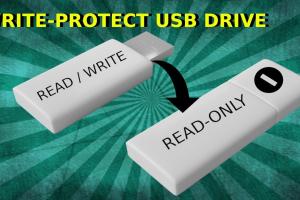Easily Remove the “Read Only” State from a USB Drive on PC: A Comprehensive Guide

-
Quick Links:
- Introduction
- Understanding the Read-Only State
- Common Causes of Read-Only State
- Step-by-Step Guides to Remove Read-Only State
- Software Tools to Remove Read-Only State
- Case Studies and Real-World Examples
- Expert Insights
- Preventive Measures
- FAQs
- Conclusion
Introduction
USB drives are essential tools for data storage and transfer, but encountering a read-only state can be frustrating. This comprehensive guide aims to help you easily remove the “read only” state from a USB drive on PC, ensuring you can use it effectively without hindrance.
Understanding the Read-Only State
The read-only state prevents users from modifying or deleting files on the USB drive. This can be a protective feature to secure important data, but it can also lead to inconveniences when you need to edit or remove files.
What Does Read-Only Mean?
When a USB drive is in a read-only state, it means that the operating system has restricted write permissions. This can happen due to various factors including physical write protection switches, system settings, or file corruption.
Common Causes of Read-Only State
- Physical write protection switch is enabled
- File system errors on the USB drive
- Corrupted files or partitions
- Operating system settings or restrictions
- Malware infections that alter file permissions
Step-by-Step Guides to Remove Read-Only State
Method 1: Using Diskpart Command
- Press Windows + R to open the Run dialog.
- Type cmd and press Enter to open the Command Prompt.
- Type diskpart and press Enter.
- Type list disk to view all connected drives.
- Identify your USB drive from the list and type select disk X (replace X with your USB drive number).
- Type attributes disk clear readonly and press Enter.
- Type exit to close Diskpart.
Method 2: Modifying Registry Editor
**Warning:** Modifying the registry can cause serious issues if done incorrectly. Backup your registry before proceeding.
- Press Windows + R, type regedit, and press Enter.
- Navigate to HKEY_LOCAL_MACHINE\SYSTEM\CurrentControlSet\Control\StorageDevicePolicies.
- Look for a key named WriteProtect.
- If it exists, double-click it and set its value to 0.
- If it doesn't exist, right-click in the right pane, select New > DWORD (32-bit) Value, name it WriteProtect, and set its value to 0.
- Close the Registry Editor and restart your PC.
Method 3: Using Windows File Explorer
- Insert your USB drive into the PC.
- Open File Explorer and right-click on the USB drive.
- Select Properties.
- Under the General tab, uncheck the Read-only box if it is checked.
- Click Apply and then OK.
Software Tools to Remove Read-Only State
If the above methods do not work, consider using third-party software tools designed to fix USB drive issues.
- Rufus: A tool for formatting USB drives and removing read-only states.
- AOMEI Partition Assistant: Offers advanced partition management features.
- EaseUS Partition Master: Can help with partition issues and access restrictions.
Case Studies and Real-World Examples
Many users have reported success with these methods. For instance, a case study involving a small business showed that using the Diskpart method resolved the issue in under 10 minutes, allowing employees to access necessary files promptly.
Expert Insights
Experts recommend regularly checking USB drives for file system errors. Tools like CHKDSK can be used for this purpose. Keeping your operating system and drivers updated can also prevent issues related to drive accessibility.
Preventive Measures
- Always safely eject your USB drive.
- Regularly scan for malware and viruses.
- Keep backups of important files.
- Use reliable formatting tools.
FAQs
1. What does read-only mean on a USB drive?
Read-only means that the data on the USB can be viewed but cannot be modified or deleted.
2. How can I tell if my USB drive is write-protected?
If you cannot delete, modify, or add files, it may be write-protected.
3. Can a read-only USB drive be fixed?
Yes, there are several methods to remove the read-only state, including using command prompt, registry editor, or third-party software.
4. What causes a USB drive to become read-only?
Common causes include physical write protection, file system errors, or malware infections.
5. Are there risks in modifying the registry?
Yes, incorrect changes to the registry can lead to system instability. Always back up your registry before making changes.
6. Can I remove write protection physically?
Some USB drives have a physical switch that can be toggled to enable or disable write protection.
7. What should I do if the USB drive is corrupted?
You may need to format the drive, but this will erase all data. Always try to recover important files first.
8. Does formatting a USB drive remove the read-only state?
Yes, formatting typically removes the read-only state, but it also deletes all data on the drive.
9. Can I use a USB drive with a read-only state on different computers?
Yes, but the read-only state will persist across different computers unless resolved.
10. How can I prevent my USB drive from becoming read-only again?
Ensure you safely eject your USB, regularly check for malware, and keep backups of your data.
Conclusion
Removing the read-only state from a USB drive is crucial for seamless data management. By following the methods outlined in this guide, you can effectively troubleshoot and resolve this common issue, ensuring that your USB drive remains a reliable storage solution. Remember to implement preventive measures to avoid future occurrences.